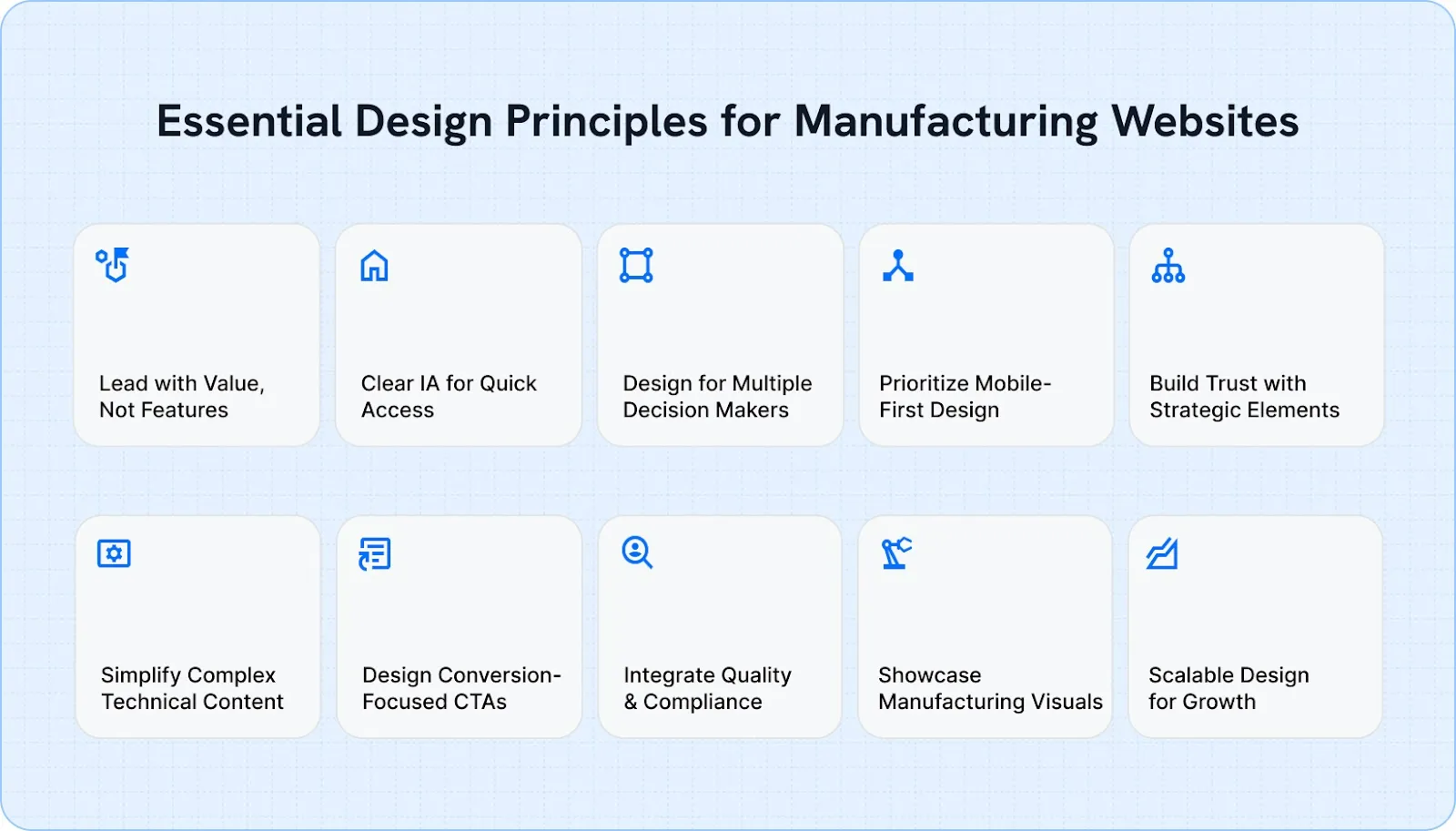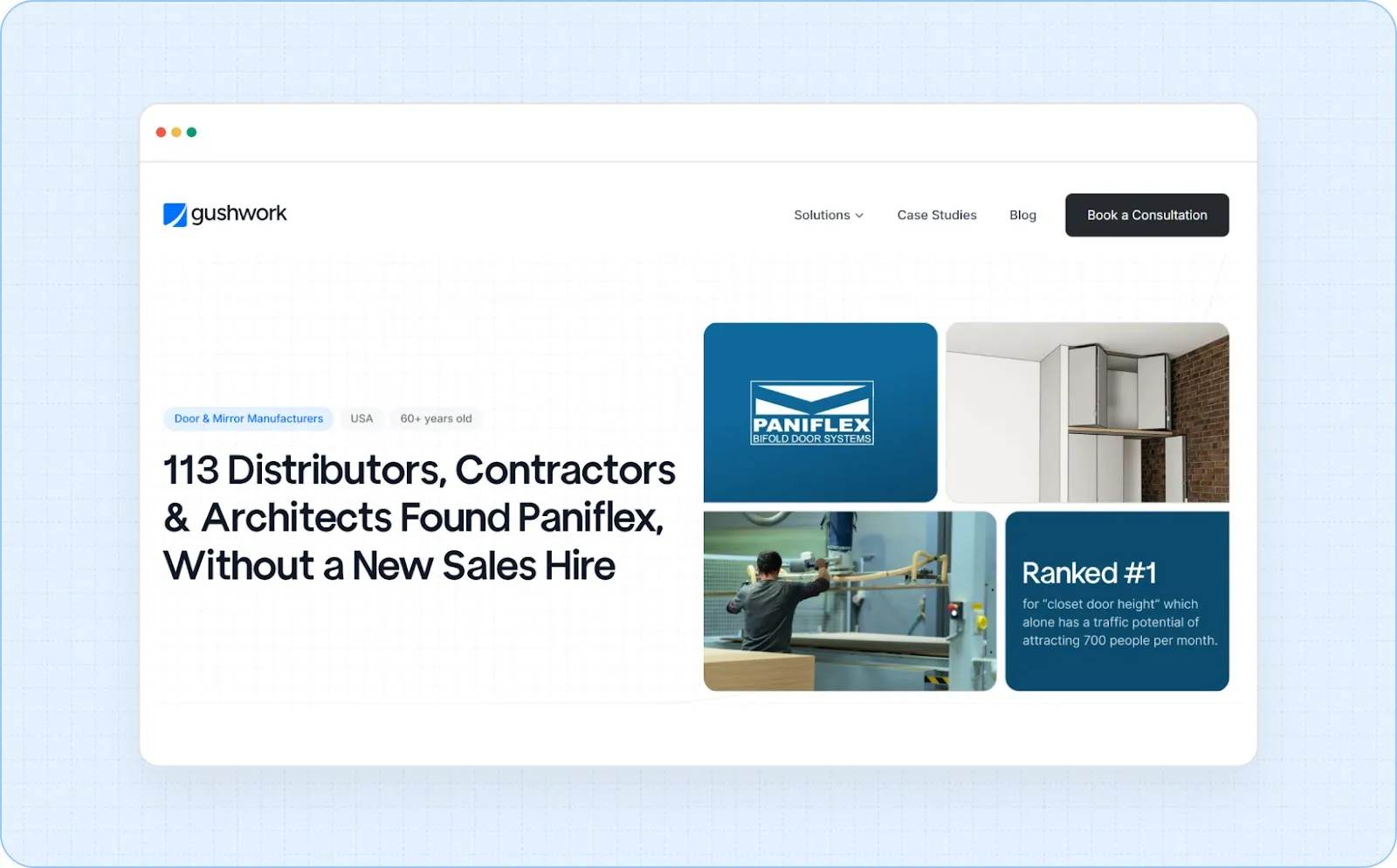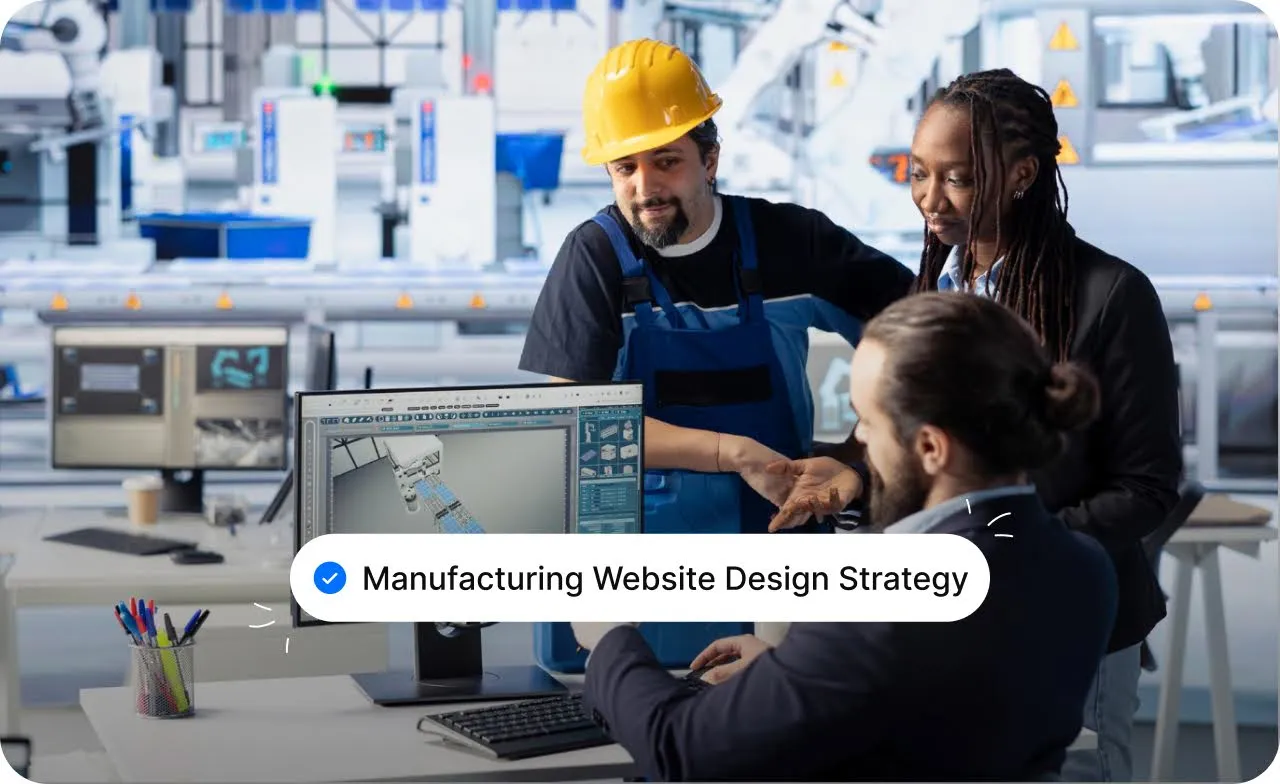Your website is often the first impression potential clients have of your manufacturing business; make sure it speaks volumes. A strong design doesn't just showcase your products; it builds trust, highlights your expertise, and sets the tone for long-term success.
It should be user-friendly, mobile-responsive, and optimized for search engines to ensure that potential clients can easily find and navigate your site. Moreover, a clear and organized layout can enhance customer experience, making it simple for visitors to access essential information like product specs, pricing, and contact details.
This comprehensive guide will break down key considerations, like functionality, speed, and visual appeal, to help you select a design that meets both your business goals and your customers' needs.
The Strategic Foundation: 10 Must-Know Design Principles for Manufacturing Websites

Building a website for your manufacturing company isn’t just about aesthetics; it's about creating a strategic platform that fuels your business growth, attracts quality leads, and builds trust with your audience. As the manufacturing industry becomes more competitive and digitally driven, your website is often the first point of contact with potential clients.
Here are 10 essential design principles that will not only enhance user experience but also improve your website’s effectiveness in generating leads and driving conversions.
1. Lead with Value, Not Features
Manufacturers often make the mistake of showcasing a list of features or technical specifications right off the bat. But remember, your audience, whether it's a procurement officer, engineer, or C-suite executive, doesn’t need to be overwhelmed by every detail upfront.
Highlight your core value proposition immediately, making it crystal clear what differentiates your company. Whether it's faster production times, unmatched quality standards, or eco-friendly practices, position these elements prominently on your homepage.

Tip: Lead with statements like:
- “Get precision-engineered parts delivered in 48 hours”
- “ISO-certified manufacturing for aerospace reliability”
2. Clear Information Architecture for Quick Access
Your manufacturing website needs to present technical and complex information in a way that’s simple to navigate. Think about creating a website layout where the content is broken down into digestible chunks that match your buyer’s journey. Ensure your site map allows for quick access to:
- Products/Services: Clearly list offerings with specs and details for each product.
- Capabilities: Include equipment lists, certifications, and production capacity.
- Industries Served: Highlight industry-specific solutions with relevant case studies.
- Quality & Compliance: Showcase your certifications and industry standards (e.g., ISO, CE, UL).
- Company Information: Show your company’s history, mission, and team, giving a face to your brand.

3. Design for Multiple Decision Makers
B2B manufacturing purchasing decisions typically involve a team of decision-makers, each looking for different types of information. A procurement manager might care more about costs and delivery times, while engineers will focus on technical specifications. Your design should cater to both by:
- Layering content: Have quick, scannable data for time-pressed visitors and detailed resources (white papers, case studies) for those seeking more in-depth information.
- Creating dedicated pages for specific audiences or personas.
- User-friendly filtering options: This helps users quickly find the most relevant information based on their role.

4. Prioritize Mobile-First Design
With 60% of B2B buyers now researching suppliers via mobile devices, optimizing your manufacturing website for mobile isn’t optional anymore; it’s necessary. Mobile-first design ensures that your website is responsive, easy to navigate, and functional across all devices, especially smartphones and tablets. Key considerations for mobile optimization include:
- Touch-friendly navigation for easy browsing.
- Content that’s automatically scaled to fit different screen sizes, eliminating the need for zooming.
- Fast loading times, as slow mobile sites can increase bounce rates.
5. Build Trust with Strategic Elements
Manufacturing partnerships are long-term commitments, and building trust is a critical part of the buying process. To foster trust on your website:
- Display industry certifications prominently (e.g., ISO, CE, UL).
- Show client testimonials that include real company names and photos for authenticity.
- Present detailed case studies that demonstrate how you solve real-world problems.
- Invest in professional images of your team, facilities, and products.
- Display your security badges to reassure users that their data is safe.
6. Simplify Complex Technical Content
Manufacturing businesses often need to present complex, technical data, whether it’s detailed specifications, CAD drawings, or product comparisons. Make sure you provide content that is:
- Visually digestible: Use diagrams, technical drawings, and comparison charts.
- Expandable: Allow users to click or hover to see additional information without overwhelming them with excessive details.
- Accessible: For visitors who need to download CAD files or product guides, ensure that downloads are quick and easy.
7. Design Conversion-Focused CTAs
Effective calls to action (CTAs) guide your visitors toward the next step in the sales process. The key is to make sure your CTAs are:
- Action-oriented and specific: Instead of generic CTAs like “Contact Us,” try using phrases like "Get Your Custom Quote Today" or "Download Product Spec Sheet."
- Located strategically: Place them in prominent areas where users are most likely to take action (e.g., after reading a product description, on landing pages, or in the footer).
- Easy to find: Make buttons large and colorful enough to catch the eye without being obtrusive.
8. Integrate Quality and Compliance Messaging
For manufacturing businesses, quality assurance and compliance are often the most important selling points. Build these into your website’s design:
- Dedicated quality pages showcasing certifications, testing procedures, and product standards.
- Visual cues: Use icons, banners, and certification badges to reinforce compliance.
- Clear, consistent messaging throughout your content.
9. Showcase Manufacturing Capabilities with Visuals
As a manufacturer, showing what you do is crucial. Photos and videos bring your processes to life, helping visitors connect with your company on a personal level. Consider adding:
- High-quality photos of your facilities and equipment.
- Process videos that show your operations in action.
- Customer testimonials in video form for greater authenticity.
- Images of your team engaged in daily work to humanize your brand.
10. Plan for Growth with Scalable Design
Manufacturing businesses don’t stay static; they grow, expand, and evolve. Your website must be designed to accommodate this growth. Scalable design means that as your company adds:
- New products or services
- Additional team members
- Upgrades in facilities or certifications
By adhering to these essential principles, you’ll ensure your website becomes a powerful tool for driving growth, gaining leads, and building a strong online presence.
Remember that your website is not just a brochure, it's your digital business hub that works 24/7 to communicate your brand's value and convert visitors into long-term clients.
Beyond Design: The Three Pillars of Manufacturing Website Success

Design is only the starting point; what truly drives success is how well you integrate your website with broader strategic elements. To maximize ROI, manufacturing websites must focus on three critical components: SEO, content marketing, and CRM integration.
These often-overlooked pillars can transform a good website into a powerful tool that drives business growth and competitive advantage.
Let’s dive into these strategies that ensure your website not only looks good but also works hard for you.
Pillar 1: GET FOUND – Strategic SEO That Puts You in Front of Ready-to-Buy Manufacturers
Even the best-designed website won’t do you much good if your target audience can’t find it. Manufacturing SEO is about much more than basic keyword optimization. It's a specialized strategy designed to ensure your site appears when your ideal customers are actively searching for manufacturing solutions.
Manufacturing SEO Priorities That Drive Discovery:
- Local SEO optimization: Target manufacturing hubs where your ideal clients operate, making sure your website appears in geographically relevant searches.
- Technical keyword targeting: Understand the exact search phrases that procurement specialists, engineers, and supply chain managers use when they look for solutions. This could be long-tail keywords such as “precision machining for automotive parts.”
- Voice search optimization: B2B buyers often use voice search on mobile devices during meetings or facility visits. Optimize your site for voice search by incorporating natural language phrases and questions.
- Schema markup: Implement structured data on your pages to generate rich snippets in search results, showcasing your key capabilities directly in the SERPs.
- Page speed optimization: In a world where users demand instant access, a fast-loading website ensures users don’t leave due to technical content or large images, especially on mobile.
A well-integrated SEO strategy ensures that your website design supports these technical SEO needs, and clean code, fast loading times, and a clear content structure are essential. This integration helps you rank higher and stand out in search results, giving you a competitive edge by being found when your prospects are searching for solutions.
Result: Your ideal customers find you first, positioning you as the leader in their search, and allowing you to lead the conversation from the very beginning.
Pillar 2: GET ENGAGED – Content Marketing That Converts Browsers into Buyers
A stunning design gets users to your website, but it’s your compelling content that keeps them engaged and converts them into qualified leads. Manufacturing content marketing isn't about random blog posts or superficial product descriptions; it's about delivering targeted, valuable resources that turn visitors into trusted prospects.
Content Strategy That Builds Authority and Trust:
- Technical guides and whitepapers: Show your expertise in solving specific problems within your industry. These resources should demonstrate how your solutions directly address your prospects’ pain points.
- Detailed case studies: Highlight real-world success stories with measurable results that demonstrate ROI for companies similar to your target audience.
- Process documentation: Build trust in your manufacturing capabilities by showcasing your operational efficiency, quality control, and reliability through documented processes.
- Industry trend analysis: Position yourself as a forward-thinking partner by sharing insightful analyses of current trends and their potential impact on the industry.
- Interactive FAQ sections: Address common concerns proactively to help potential buyers feel confident in their decision-making process.
Your content must align with the user journey, moving visitors from initial interest to deeper engagement.
This educational content builds trust, showcases your authority, and significantly shortens sales cycles. It’s not about stuffing keywords; it’s about genuine value that resonates with your audience.
Result: Visitors stay longer, engage more, and arrive at sales conversations already convinced of your expertise, making your sales team’s job easier and leading to higher conversions.
Pillar 3: GET RESULTS – CRM Integration That Transforms Website Activity into Trackable Revenue
Here’s where many manufacturing websites fall short. You can drive traffic, but without proper CRM integration and performance monitoring, you’ll never know which content or actions truly matter. Proper integration allows you to track and analyze website activity in real-time, turning visitor actions into actionable sales insights.
Performance Tracking That Drives Business Growth:
- Lead scoring systems: Based on page views, content consumption, and engagement depth, lead scoring helps prioritize high-potential leads.
- Behavioral tracking: Track the buyer journey, which pages are they visiting, what content are they engaging with, and when do they drop off? These insights optimize conversion paths.
- Automated lead nurturing: Triggered by specific website actions (like a case study download or a request for a quote), this nurturing keeps prospects engaged until they’re ready to make a purchase.
- Sales team alerts: Automatically notify sales teams when high-priority actions take place, such as pricing page visits or repeated visits to your product/service pages.
- ROI measurement: Connect website activity to closed deals, attributing revenue to specific actions like form submissions, downloads, or consultations.
Advanced Success Monitoring:
- Conversion path analysis: Determine which content and pages are most effective at moving leads toward a sale.
- Sales cycle impact measurement: Understand how your website-generated leads compare to those generated by other marketing channels in terms of time to conversion.
- Customer acquisition cost tracking: Measure the cost of acquiring customers through your website versus traditional marketing methods.
Without CRM integration, your website is just a digital brochure. But with it, you’ll gain real-time visibility into which activities, pages, and content drive revenue. Performance tracking connects your website’s efforts directly to your bottom line.
Result: You’ll know exactly which website elements are driving revenue, giving you the power to continuously optimize for better business outcomes rather than just tracking vanity metrics like traffic.
Also Read: 25+ Manufacturing Website Design Examples That Generate Leads (Strategy Checklist Included)
Three Manufacturing Website Designs That Drive Results
Your manufacturing website isn’t just a digital brochure; it’s a powerhouse for lead generation, trust-building, and revenue-driving.
Let’s explore three manufacturing websites that nail it by applying strategic design principles, with the added power of Gushwork’s automation and AI-driven tools.
These case studies showcase websites that don’t just look good but work hard to deliver measurable business results.
Case Study 1: John Maye Company – Where Packaging Meets Flexibility
John Maye Company understands that timing and flexibility are crucial in packaging equipment rentals. The homepage hits you with clear, benefit-oriented messaging right away: “Flexible Terms for Seasonal Peaks” and “Emergency & Same-Day Rentals.”
These address the most common pain points for manufacturing companies: cash flow and urgent equipment needs.
Why This Design Shines:
- Immediate Problem-Solution Clarity: The hero section directly addresses key pain points for manufacturing companies that require flexibility in equipment, something rental companies don’t always highlight.
- Service-Specific Navigation: The site cleverly differentiates rental services from sales, catering to two very different types of buyers and decision-making processes.
- Trust-Building Specifics: Rather than vague promises like "quality service," they provide real commitments: “All Rentals Include Maintenance” and “Same-Day Rentals.” This helps reduce buyer risk perception, a game-changer in the rental market.
How Gushwork Powers John Maye’s Strategy:
By integrating Gushwork’s AI-driven automation, John Maye has optimized lead capture and response time, ensuring they quickly address high-intent visitors.

Gushwork’s lead scoring and automated follow-up ensure that prospects who are looking for urgent equipment rentals are contacted promptly, turning high-conversion visitors into customers without delay.
Revenue Driver: By offering rental options prominently, John Maye has expanded their market. Companies that might never buy equipment still generate recurring revenue through rentals, broadening their customer base.
Case Study 2: Paniflex – Precision Manufacturing for the Win
Paniflex is laser-focused on precision. Their competitive edge? “Manufacturing doors to the nearest quarter inch” with state-of-the-art equipment like CNC routers and computerized cutting tables. This website doesn’t shy away from showcasing exactly what they do, and it works.
Why This Design Shines:
- Technical Differentiation at the Forefront: Paniflex doesn’t bury its precision capabilities in an “About Us” section. They put it front and center, appealing directly to the architects and contractors who need exact specifications.
- Transparency in Process: By mentioning their use of R2D2's software and automated equipment, they offer a level of transparency that builds confidence in their manufacturing processes and ensures consistent quality.
- Market-Specific Messaging: Recognizing that architects and contractors value precision over generic quality claims, the messaging is tailored to their needs, addressing the specific challenges these professionals face.
How Gushwork Powers Paniflex’s Strategy:

With Gushwork’s content marketing automation, Paniflex is able to distribute targeted content (such as technical whitepapers and case studies) to high-value leads, improving lead engagement and conversion rates. Behavioral tracking helps identify when these professionals are in the research phase, enabling tailored content delivery that matches their specific needs.
Revenue Driver: By positioning their services as cost-saving, eliminating the need for modifications to openings, they justify premium pricing, attracting clients who prioritize precision over cost.
Case Study 3: Chemiteck – Chemistry Meets Web Design
While Chemiteck's site might not be visually loaded, its domain positioning and URL structure show that it’s aimed at industrial chemical solutions. This offers a valuable lesson on designing for the chemical industry, where safety and regulatory compliance should take center stage.
Essential Elements for Chemical Manufacturing Websites:
- Regulatory Compliance Prominence: Safety and regulatory certifications are must-haves for chemical manufacturers. Chemiteck’s site should clearly showcase compliance and safety credentials (e.g., MSDS sheets, certifications), reassuring visitors of their reliability.
- Application-Focused Organization: Instead of organizing by chemical types, this site should focus on industries served and specific applications. Buyers are more interested in solving industry-specific problems than browsing through a generic product list.
- Technical Support Integration: Chemical manufacturers often require technical consultation. A website that features easy access to support (e.g., troubleshooting resources, application engineering contact) will increase buyer confidence.
- Safety & Handling Information: Chemical manufacturers must provide immediate access to safety data. Chemiteck should highlight MSDS sheets and safety handling procedures on its homepage to create trust and build compliance credibility.
How Gushwork Powers Chemiteck’s Strategy:
Gushwork’s CRM and performance tracking tools ensure that Chemiteck’s website is not just a catalog of chemicals but a revenue-generating asset.
Behavioral tracking helps segment visitors based on their interests (e.g., those looking for safety certifications or application specifics) and triggers automated nurturing sequences to guide these leads through the sales funnel efficiently.
Lead Generation for Chemical Manufacturing: Successful chemical manufacturing websites turn technical problem-solving into a selling point. By focusing on process optimization, application expertise, and safety, Chemiteck can attract qualified leads who value industry knowledge over simply selling chemicals.
Key Takeaways for Your Manufacturing Website Design:
- John Maye demonstrates that clear value propositions and specific offerings in rental services can help drive urgent, high-conversion leads.
- Paniflex highlights the importance of market-specific messaging and technical transparency to pre-qualify high-value leads and command premium pricing.
- Chemiteck shows how safety, compliance, and application-specific solutions are critical for building trust in industries where regulatory standards are paramount.
The Integration Strategy: Making It All Work Together
A manufacturing website is more than just a digital brochure. To generate leads and drive growth, it must integrate design, content strategy, SEO, and CRM into a unified system.
These elements should work together seamlessly, guiding visitors from their first impression to becoming qualified leads and, ultimately, customers.
Here’s how it works:
1. Design: The First Impression
Your website design is the first thing visitors notice. It should be easy to navigate, user-friendly, and responsive across all devices. The design needs to guide users to the key information that will help them make decisions, like clear calls to action (CTAs) and simple navigation.
2. Content: Building Trust and Authority
Content makes your website more than just a page of information; it builds trust. Your content should speak directly to your audience's needs, addressing their pain points with educational resources, like case studies, technical guides, and industry insights.
It establishes your company as an expert in your field, building credibility and moving visitors closer to making a purchasing decision.
3. SEO: Helping the Right People Find You
SEO ensures your website appears in search results when potential customers are looking for your services. By using targeted keywords, optimizing your pages, and focusing on mobile-friendly design and fast load times, you’ll improve visibility and attract qualified leads.
Without SEO, even the best design and content won’t be found by your ideal customers.
4. CRM: Turning Visitors Into Leads
CRM integration tracks and nurtures leads. With platforms like Gushwork’s CRM, you can automatically capture visitor data, track their behavior, and identify high-potential leads based on actions like form submissions or product page views.
CRM allows you to nurture leads through personalized follow-ups, guiding them through the decision-making process.
Why This Integration Works: The Big Picture
Manufacturers often optimize these elements separately, leading to missed opportunities. When design, content, SEO, and CRM work together, you get:
- Qualified leads who are ready to buy.
- A shortened sales cycle with pre-qualified prospects.
- Sales intelligence that helps your team close deals faster.
With this integrated approach, your website becomes a lead-generation machine that continuously works for your business, giving you a competitive edge.
Implementation Roadmap for Manufacturing Website Success
Creating a successful manufacturing website isn't just about a sleek design, it’s about a strategic approach that drives real business growth. To make your website your hardest-working salesperson, follow this roadmap to align design, content, SEO, and CRM systems for maximum impact.
1. Start with Strategic Foundation
Before diving into design, define your unique value proposition and identify your ideal customer profile (ICP). Know exactly who you are targeting and what problems your manufacturing solutions solve. This clarity will guide the rest of your website’s development, ensuring that every element speaks directly to the needs and pain points of your audience.
2. Design for User Journey
Map out your typical sales process, from awareness through to decision. Your website must support each stage of the journey:
- Awareness: Create a clear first impression with a user-friendly design and compelling content.
- Consideration: Provide in-depth resources, such as case studies and technical specifications, to help prospects evaluate your offerings.
- Decision: Feature strong calls to action (CTAs) like "Request a Quote" or "Book a Demo" to drive conversions.
By aligning your design with the user journey, you can guide visitors smoothly through their decision-making process.
3. Implement Technical Excellence
A visually appealing website is worthless if it’s slow or hard to navigate. Prioritize the following technical elements:
- Fast loading speeds to improve user experience and search engine rankings.
- Mobile optimization so users can easily access your site on any device.
- Clean, structured code that supports both the user experience and SEO visibility.
These elements are critical for both user engagement and ensuring your site ranks well in search engine results.
4. Create Content Assets
Content is the heart of a successful manufacturing website. Focus on creating valuable, industry-specific content that establishes authority and builds trust with your audience. This can include:
- Case studies that showcase real-world success stories.
- Technical resources like whitepapers, product specs, and guides.
- Industry insights that position your brand as an expert and thought leader.
This content not only helps with SEO but also nurtures leads through educational and trust-building resources.
5. Integrate CRM Systems
CRM systems are essential for tracking and nurturing leads effectively. Integrate your website with a CRM platform to:
- Track visitor behavior and identify high-potential leads.
- Segment leads based on engagement, allowing you to send personalized follow-ups.
- Automate lead nurturing with timely emails, helping prospects move through the sales funnel.
This integration ensures that you don’t just attract visitors; you actively convert them into qualified leads.
6. Measure and Optimize
Finally, measure the effectiveness of your website. Track key performance indicators (KPIs) such as:
- Website traffic and bounce rates.
- Lead conversion rates.
- Engagement with content (downloads, video views, etc.).
Monitor these metrics alongside business outcomes like revenue growth or sales cycle reduction. Use this data to continuously refine your website and marketing strategy for ongoing optimization.
Make Your Website Your Hardest-Working Salesperson
By following this roadmap, your manufacturing website will evolve into a strategic asset that supports every stage of the customer journey, from attracting visitors to converting them into loyal customers. With the right combination of design excellence, content authority, SEO visibility, and CRM integration, your website will drive measurable growth for your business.
To ensure seamless integration and maximize your website's potential, Gushwork offers advanced CRM tools and AI-driven automation that streamline lead capture, nurturing, and conversion.
By connecting your website to real-time performance data and visitor insights, Gushwork ensures your website doesn’t just attract traffic, it turns that traffic into sales, helping your business grow faster and smarter.
FAQs
Q1. How do I ensure my manufacturing website appeals to my target audience?
A1. To appeal to your target audience, focus on their specific needs. Use clear messaging that highlights your unique value, such as faster production or specialized services. Ensure your site speaks directly to decision-makers like engineers, procurement managers, and business executives by tailoring your content to address their concerns and pain points.
Q2. What role does website speed play in user experience and SEO?
A2. Website speed is essential for both user experience and SEO performance. A fast-loading website reduces bounce rates and keeps visitors engaged. For SEO, Google ranks faster websites higher, improving your chances of being discovered by potential clients. Tools like image optimization and code clean-up can help improve speed.
Q3. Should I include interactive features like product configurators or quote generators?
A3. Yes, interactive features such as product configurators or quote generators enhance user engagement and simplify the buying process. These tools allow visitors to customize products or get immediate quotes, leading to higher conversion rates by providing instant value and reducing friction in the decision-making process.
Q4. How important is it to align my website’s design with my overall brand identity?
A4. Consistency between your website design and your brand identity is key to building trust and recognition. Ensure that your color scheme, fonts, and logo reflect your brand’s values and personality. A cohesive design creates a professional image that resonates with visitors and strengthens brand loyalty.
Q5. How do I optimize my website for different stages of the buyer’s journey?
A5. To optimize for different buyer stages, tailor your content to address specific needs at each point. For awareness, focus on broad industry insights. For consideration, offer detailed product specs and case studies. For decision-making, use clear CTAs and offer quotes or product demos to convert prospects into buyers.
Q6. What are the benefits of using case studies and testimonials on my website?
A6. Case studies and testimonials provide social proof and demonstrate real-world success. They help build trust by showcasing how your solutions have positively impacted similar clients. Featuring detailed case studies allows potential customers to see your capabilities in action, while testimonials humanize your brand and offer credibility.




















.webp)








.webp)
.svg)


.svg)
.svg)
.svg)







.svg)